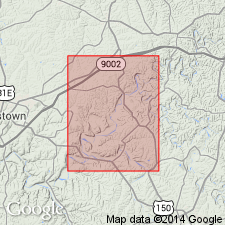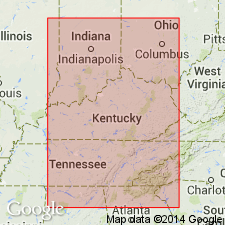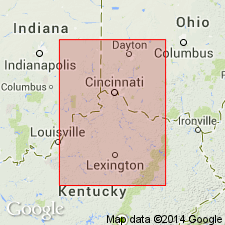
- Usage in publication:
-
- Bardstown Member*
- Modifications:
-
- Named
- Dominant lithology:
-
- Limestone
- Shale
- AAPG geologic province:
-
- Appalachian basin
Summary:
Named middle member of three of Drakes Formation. Occurs on western side of Cincinnati Arch in KY; overlies Rowland Member, underlies Saluda Dolomite Member. Gray thin-bedded limestone, muddy limestone, and shale. 29 ft thick at type section. Approximately replaces the Liberty Limestone (Formation) on the west side of the Cincinnati Arch in KY.
Source: GNU records (USGS DDS-6; Reston GNULEX).

- Usage in publication:
-
- Bardstown Member*
- Modifications:
-
- Overview
- AAPG geologic province:
-
- Cincinnati arch
Summary:
The Bardstown Member of the Drakes Formation occurs on the western side of the Cincinnati Arch in south-central KY. Consists of gray to greenish-gray, fine- to medium-grained limestone and bioclastic to coquinoid limestone. Thickness is 12 to 40 feet. Overlies the Rowland Member and underlies the Saluda Dolomite Member, both of the Drakes Formation. The Bardstown is of Late Ordovician (Richmondian) age.
Source: GNU records (USGS DDS-6; Reston GNULEX).

- Usage in publication:
-
- Bardstown
- Modifications:
-
- Not used
- AAPG geologic province:
-
- Cincinnati arch
Summary:
The Cincinnatian Series is divided into five depositional sequences in this report, which correspond to lithostratigraphic units. The following stratigraphic names in KY should be abandoned as they have been applied to bodies of rock already named in downramp areas of OH and IN: Bardstown (=Lower Whitewater), Reba (=Oregonia), Stingy Creek (=Mount Auburn), Calloway Creek (=Bellevue), and Clays Ferry (=Fairview). The following units in KY, OH, and IN lump dissimilar facies and straddle sequence boundaries and therefore should be abandoned: Drakes, Ashlock, Dillsboro, Tanners Creek, and Bull Fork. Grant Lake has been defined in several different ways and should be abandoned. Several units will be redefined at a later date, including the Upper Whitewater and the "Sunset" of OH and IN.
Source: GNU records (USGS DDS-6; Reston GNULEX).

- Usage in publication:
-
- Bardstown Member*
- Modifications:
-
- Age modified
- AAPG geologic province:
-
- Cincinnati arch
Summary:
Age of Bardstown Member of Drakes Formation is refined to Cincinnatian (Richmondian).
Source: GNU records (USGS DDS-6; Reston GNULEX).
For more information, please contact Nancy Stamm, Geologic Names Committee Secretary.
Asterisk (*) indicates published by U.S. Geological Survey authors.
"No current usage" (†) implies that a name has been abandoned or has fallen into disuse. Former usage and, if known, replacement name given in parentheses ( ).
Slash (/) indicates name conflicts with nomenclatural guidelines (CSN, 1933; ACSN, 1961, 1970; NACSN, 1983, 2005, 2021). May be explained within brackets ([ ]).

